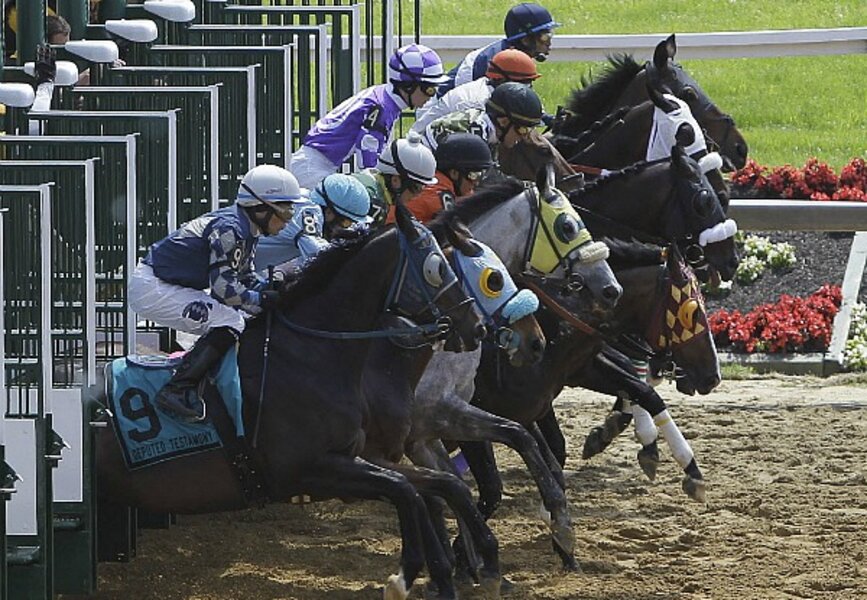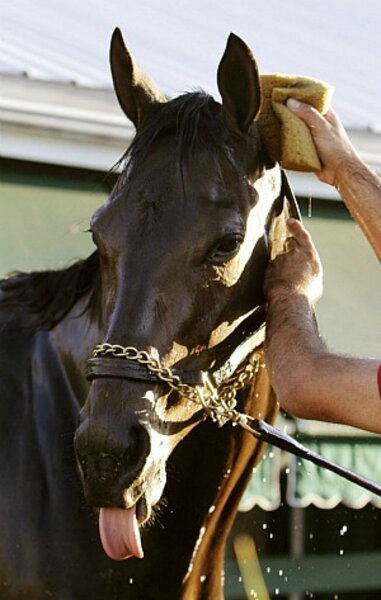The Preakness: More important than its glamorous Kentucky Derby cousin
Loading...
| Baltimore
The Preakness may be America’s greatest horse race. That‘s probably not as important a boast as it used to be, given the sport of king’s long US decline. But the underappreciated middle leg of the Triple Crown is a superior sporting moment to its more glamorous Kentucky Derby cousin.
The Kentucky Derby goes first, to be sure. It’s got a song (“My Old Kentucky Home”) a drink, and better women’s hats. Asked to name one national horse race most Americans would probably come up with the Derby.
The Preakness is the Triple Crown’s backstretch, however, and as any rail fly knows, it is in the backstretch of an equine contest that the prospect of drama emerges. Every Kentucky Derby winner may win a Triple Crown champion. The Preakness is when that becomes a real possibility – or dreams are left in the Old Hilltop dust.
RECOMMENDED: Kentucky Derby 2011: Five fantastic finishes of the past
As Preakness 2011 post time approaches, here are three more reasons the race is better than the Derby, (or the Belmont Stakes, for that matter):
IT’S NOT STUFFY. The Kentucky Derby is so enamored of its history that sometimes it seems more like a reenactment of a race from the 1800s than an event of modern times. Those hats. The livery. The song.
The Preakness, on the other hand, has an actor in a centaur suit as a mascot. Yes, that’s occasioned a lot of comment – his name is “Kegasus”, and the hijinks in the infield have gotten out of hand in years past.
But in general the Preakness is a race regular people go to – and look forward to attending, we might add. It’s a fun show, not Masterpiece Theater with hooves.
IT’S URBAN. The Kentucky Derby is in Louisville, which is a city, and the Belmont is near New York, which is certainly a city, but neither is of their urban area, if you know what we mean. The Kentucky Derby harkens back to a halcyon rural past. The Belmont is actually on Long Island. Only the Preakness is part and parcel of the city in which it resides.
That’s Baltimore, in case you didn’t know. The Preakness is run at Pimlico, which is on the northern edge of the city most famous now for decay shown in “The Wire.” And Pimlico is no Wrigley Field, surrounded by gentrification. Most of the track is surrounded by the Pimlico neighborhood, which is fairly gritty, though not awful. A big source of cash this month for residents is allowing Preakness attendees to park on their lawns.
But Baltimore isn’t all drug deals and David Simon-scripted drama. If you attend the Preakness it’s just a short hop to “Café Hon” for lunch.
You can visit the fabulous National Aquarium down on the Inner Harbor, take in an Orioles game. Tickets are easy to get – the Birds had hope in May, but for the moment they’re playing crummy.
SEABISCUIT. And if you want to talk history, the Preakness – or, more precisely, Pimlico itself – will always have Seabiscuit and the Match of the Century, arguably the greatest horse race of all time.
Seabiscuit was an undersized, knobby-kneed thoroughbred given to sleeping and eating for long periods. He was also a great racing champion and one of the most beloved US sports heroes of the Great Depression.
On November 1, 1938, Seabiscuit met Triple Crown winner War Admiral in a two-horse match contest at Pimlico. Special trains from all across the nation brought thousands to Old Hilltop. Forty million people listened on radio. Two hundred yards from the wire the horses remained tied.
At that point Jockey George Woolf eased up a bit so that Seabiscuit could mark the presence of his rival. The pudgy, determined little horse then lit off, pulling away and winning by four lengths.
Today’s Preakness is run over the same ground.
RECOMMENDED: Kentucky Derby 2011: Five fantastic finishes of the past






